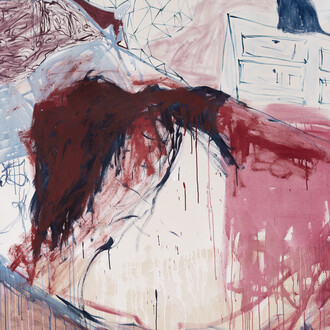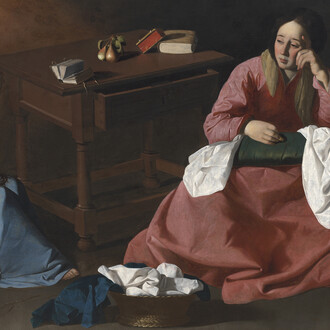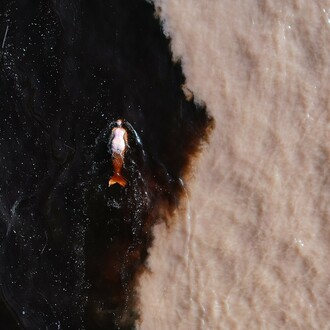Victoria Miro is delighted to present Incantations, an exhibition of new paintings conceived in dialogue with a series of photographic wall vinyls by Kudzanai-Violet Hwami. Also on view will be new bronze sculptures, the artist’s first venture into three-dimensional work.
I’ve tried to keep the idea of fragmentation at the forefront. It is all rooted in rapture, not distraction. A breakdown of inherited systems: religion, identity, gender and the body.
(Kudzanai-Violet Hwami)
Kudzanai-Violet Hwami’s paintings combine visual fragments from multiple sources, such as online and archival images, and personal photographs. Autobiographical in nature, her works address how in a digitised world of infinite images we construct a sense of self or comprehend one another in a complex social reality.
Incantations, the artist’s third solo exhibition with the gallery, features paintings installed with large-scale photographic images presented as wall vinyls. Together, these might be considered as incantations or spells that activate individual elements and their corresponding energies – ‘forces of hunger, chaos, seduction and destruction,’ the artist explains. Imagery, drawn from family photographs and religious and mythological narratives, touches upon aspects of psyche, oscillating between individual and communal life, and territories of the unconscious, instinctual id and the learned behaviour of the self-critical superego.
The exhibition features a number of the artist’s acclaimed Atom paintings. These works draw inspiration from Walt Whitman’s poem Song of myself and its line ‘For every atom belonging to me as good belongs to you,’ which for Hwami speaks to an idea of liberation as well as interconnectedness. The Atom paintings comprise individual canvases that come together to form one large work. A particularly wide variety of images, ideas and themes converge within them – ‘the whole chaos and cosmos in my head,’ Hwami says – in contrast to the formal rationale of the underlying grid-like structure of canvases.
Here we discover references to a number of symbolic motifs: Persephone, queen of the underworld and goddess of harvest and fertility; Mamoyo, in Zimbabwe a Shona term for ‘my heart’ that is also used to identify lineage; devils or fallen angels, sometimes appearing dejected or depleted of force. At times, the fractures of the picture plane correspond with the psychic or structural fissures of Hwami’s figures, variously modelled or modified. Consequently, we are alerted to painterly and bodily gestures in tandem: the ways in which the figures in the paintings mirror or guard, hold or carry, both literally or metaphorically, alongside the analogue and digital processes Hwami employs – splice, repetition, superimposition, changes of scale and medium, areas of X-ray like solarisation, or reversed tonalities, alongside richly applied oil paint, seductive with gesture.
Through her process, the artist questions things that appear fixed, or possess apparent finality, opening up spaces of imagination and transformation shaped in part by her years growing up in Zimbabwe and South Africa, her interest in metaphysics and spirituality, and expressions of contemporary Black and Queer identities. In Hwami’s work, images and their accompanying narratives are endlessly reconstructed and reframed. Yet in Incantations, the artist’s restless dialogue with form and content, and the inherent tensions and frictions of her subject matter, reach a liberating, rapturous crescendo, poised between legacy – personal, cultural, art historical – and self-discovery.
















